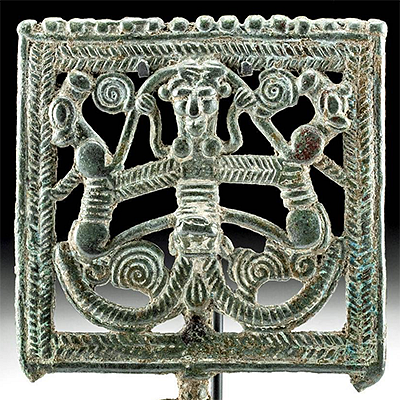Egyptian Painted Gesso / Cedar Mummy Mask
Lot 1
About Seller
Artemis Fine Arts
686 S Taylor Ave, Ste 106
Louisville, CO 80027
United States
Selling antiquities, ancient and ethnographic art online since 1993, Artemis Gallery specializes in Classical Antiquities (Egyptian, Greek, Roman, Near Eastern), Asian, Pre-Columbian, African / Tribal / Oceanographic art. Our extensive inventory includes pottery, stone, metal, wood, glass and textil...Read more
Categories
Estimate:
$1,600 - $2,400
Absentee vs Live bid
Two ways to bid:
- Leave a max absentee bid and the platform will bid on your behalf up to your maximum bid during the live auction.
- Bid live during the auction and your bids will be submitted real-time to the auctioneer.
Bid Increments
| Price | Bid Increment |
|---|---|
| $0 | $25 |
| $300 | $50 |
| $1,000 | $100 |
| $2,000 | $250 |
| $5,000 | $500 |
| $10,000 | $1,000 |
| $20,000 | $2,500 |
| $50,000 | $5,000 |
| $100,000 | $10,000 |
| $200,000 | $20,000 |
About Auction
By Artemis Fine Arts
Nov 5, 2020
Set Reminder
2020-11-05 10:00:00
2020-11-05 10:00:00
America/New_York
Bidsquare
Bidsquare : Ancient & Ethnographic From Around the World
https://www.bidsquare.com/auctions/artemis-gallery/ancient-ethnographic-from-around-the-world-5916
Ancient art from Egypt, Greece, Italy and the Near East, as well as Asian, Pre-Columbian, Native American, African / Tribal / Oceanic, Spanish Colonial, Russian Icons, Fine art, much more! All categories, all price ranges... all legally acquired and guaranteed to be as described or your money back. Artemis Fine Arts info@artemisgallery.com
Ancient art from Egypt, Greece, Italy and the Near East, as well as Asian, Pre-Columbian, Native American, African / Tribal / Oceanic, Spanish Colonial, Russian Icons, Fine art, much more! All categories, all price ranges... all legally acquired and guaranteed to be as described or your money back. Artemis Fine Arts info@artemisgallery.com
- Lot Description
Egypt, Late Dynastic to Ptolemaic period, ca. 664 to 30 BCE. A lovely example of a hand-carved cedar wood mummy mask depicting a highly stylized human face that is covered in white gesso and painted with hues of crimson, pale yellow, and black. The attractive countenance presents with almond-shaped eyes with elongated canthi beneath gently arching brows, a wide nose, pursed lips with slightly indented corners, a masculine chin and jawline, and bar-shaped ears bearing drilled 'piercings' that perhaps held additional ornamentation at one time. Atop the head is a simple, black-painted cap that rests low on the smooth forehead. Traces of four original dowel holes are visible on the verso, and two still retain portions of the original wooden dowels. Size: 6.25" W x 8.3" H (15.9 cm x 21.1 cm); 13.7" H (34.8 cm) on included custom stand.
Interestingly, cedar wood was not native to Egypt. Egypt did not have verdant forests filled with tall trees, and unfortunately most of its native lumber was of relatively poor quality. Thus, they relied on importing to acquire hardwoods - ebony imported from Africa, cedar and pine from Lebanon. One fabulous obelisk inscription by Thutmose III attests to the luxury of treasured hardwoods. It reads as follows, "They brought to me the choicest products...consisting of cedar, juniper and of meru wood...all the good sweet woods of God's Land." The rarity of cedar meant that masks like this example were reserved for those who could afford them.
Provenance: private J.H. collection, Beaverton, Oregon, USA, acquired in November 2001; ex-Edgar L. Owen, Ltd., Lake Hopatcong, New Jersey, USA
All items legal to buy/sell under U.S. Statute covering cultural patrimony Code 2600, CHAPTER 14, and are guaranteed to be as described or your money back.
A Certificate of Authenticity will accompany all winning bids.
We ship worldwide and handle all shipping in-house for your convenience.
#150064Losses to much of both ears as well as small areas of peripheries and verso as shown. Chipping and fading to areas of painted gesso, with a few stable fissures to mask and gesso, light encrustations, and inactive insect damage. Nice earthen deposits and traces of original pigment throughout. Old inventory number written in graphite on verso.Condition
- Shipping Info
-
All shipping is handled in-house for your convenience. Your invoice from Artemis Gallery will include shipping calculation instructions. If in doubt, please inquire BEFORE bidding for estimated shipping costs for individual items.
-
- Buyer's Premium



 EUR
EUR CAD
CAD AUD
AUD GBP
GBP MXN
MXN HKD
HKD CNY
CNY MYR
MYR SEK
SEK SGD
SGD CHF
CHF THB
THB














